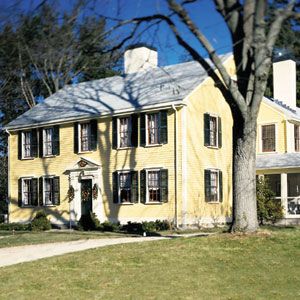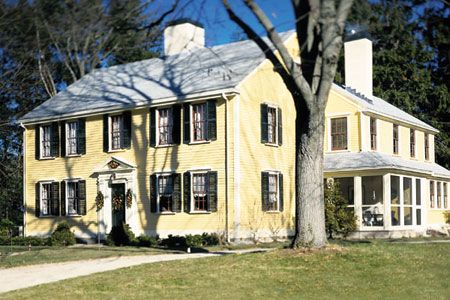
If real estate’s rule of thumb is location, location, location, then a painter’s is preparation, preparation,
preparation. Getting this all-important step right can mean the difference between a dream paint job and a nightmare of peeling, cracking and chipping. A fresh coat of paint will accentuate problems unless every imperfection, from cracks to dents to holes, has been patched. Prepare your surfaces the right way and your repairs won’t reappear shortly after your paint job is complete.
At the Milton house, my crew and I found a real mildew problem—quite unusual for the interior of any home. To get rid of it, we washed all the interior surfaces with a solution of bleach, trisodium phosphate (TSP) and warm water, and thoroughly cleaned stubborn areas with a scrub brush.
Then we began to prepare the woodwork. Many of the rooms had not been heated well over the last few years; the owners may have closed them off and left them unheated. Interior paint is not designed to withstand New England winters so much of the paint was coming off in sheets. We removed the rest with molding scrapers, being very careful not to gouge the woodwork and create more damage to the wood. To clean up edges and “feather out” the many layers of paint, we used 50 grade sandpaper—careful not to oversand as this coarse grit can also damage the wood. Successive passes with 80, 120, and then 220 grit papers smoothed out the wood’s surface. Once the woodwork was vacuumed and washed with clean water we sealed it with an oil primer.
But we weren’t done yet.
Part two of the job was “skimming” or smoothing out areas where layers of paint and holes in the wood from old hardware were visible. We applied spackling or joint compound in thin successive coats until it covered the imperfections. Then we sanded out these repaired areas with 220 grade sandpaper, and, most importantly, reprimed the repaired areas. We used an acrylic and silicone caulking compound to fill all the cracks where
the woodwork met the wall.
Finally, the woodwork was ready for its final coats of paint. But before we could finish off the woodwork, we had to deal with the walls and ceilings, which had their own set of problems.
In Milton, as in many older homes, we were faced with plaster that was falling away from the wooden lath.
To repair the damage, we removed the loose plaster and opened up ceiling and wall cracks using a hard putty knife. It’s a delicate process. If we gouge too hard, the whole wall could come tumbling down. After
cleaning up the debris, we brushed a bonding agent into the cracks and added an acrylic solution to our plaster mix to help the new plaster better adhere to the old surfaces. We applied plaster only in the cracks—never over old plaster—and filled them so they dried just a shade deeper than the old areas to prevent the repair from looking higher than the original surface. Four hours later, when the
plaster had dried, we bandaged these and other, smaller cracks with mesh fiberglass tape to reinforce the repairs. Three thin coats of joint compound hid all the repairs, which we then sanded one last time with 220 grit paper.
With necessary repair work done, we were ready to prime the walls and ceilings. Primers are formulated with a high proportion of binder to help them better adhere to the surface and the next layer of paint.
They ensure a good bond and good coverage for the finish layers of paint or wallpaper. Even after the priming was done, we sometimes found further repairs were needed and—you guessed it—we’d skim, sand and reprime all over again. The woodwork got an additional light sanding between coats with 220 sandpaper which helped make the two final coats of semi-gloss finish as smooth as could be.
Each room required approximately two days of prep work before painting could begin. While preparation is time consuming and often repetitive, it’s the most important part of the job. In a well painted room, surfaces are smooth, lines crisp and joints tight. If we’ve done our job right, you won’t see any repairs at all.
Steve Kiernan has worked as the painting contractor on This Old House projects in Watertown and Milton, Massachusetts.

